 Life on Earth and Mars: In the habitable zone
Life on Earth and Mars: In the habitable zone
As noted in part 1, Earth and Mars (and now possibly including Venus) are currently considered to be within the habitable zone of our solar system. We know, of course, that life exists on Earth, but the big question is whether life has ever existed on Mars. In order to determine this, researchers must determine if past physical conditions on Mars were suitable for life as we know it, and they would also have to find a fossilized record of such life. These tasks are part of the exploration projects of NASA and other space agencies.
Here’s what geologists currently know about the first 2.5-billion-year history of Earth.
Searching for the oldest rocks on Earth
In contrast to general belief at that time, by the late 1800s and early 1900s most scientists felt that the Earth could be billions of years old. However, proof for this assumption was not documented until 1907. At that time, Bertram Boltwood and Ernest Rutherford collaborated to use a uranium/lead radioactive decay method to determine the numerical age of some igneous rock samples. They published ages ranging from 440 to 2,200 million years for their rock samples. So began a hundred-year record of numerical dating of rocks not only from Earth but also for meteorites, moon rocks, and rocks from Mars.
Technological advances driven by World War II and the Korean War provided mass spectrometers with much better accuracy than those used early in the 20th century. With the collection of meteorites and rock samples returned from the moon by NASA astronauts in the early 1970s, our solar system and Earth were determined to be over 4.5 billion years old.
Energy sources acting on Earth have pretty much obliterated and recycled most of the rock record of the first billion years of the our planet’s history. Although very sparse, enough remains to allow for reasonably accurate interpretations of environmental conditions during this time interval (Figure 1). This record includes evidence from Earth-formed minerals and rocks and ancient rocks from the moon and meteorites. Most of this evidence has been found since the 1950s.
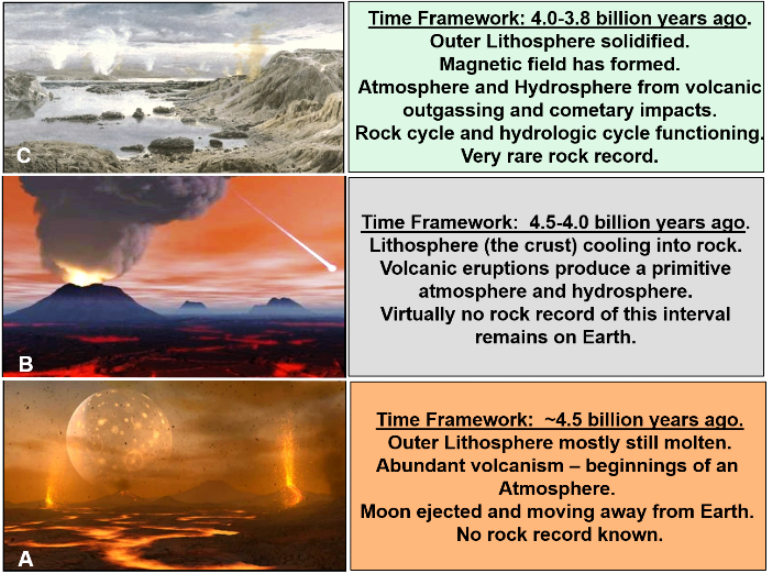
There is essentially no known rock record for the first 500 million years of Earth’s history. Although some zircons in rocks of western Australia have been dated as having formed over four billion years ago, the original rocks in which they formed have been eroded away. The remaining zircons are found as redeposited minerals in younger rocks.
Currently, the oldest remaining rocks are the Acasta Gneiss, a metamorphic rock that was first described in 1989 and occurs in the Northwest Territories of Canada. Radiometric dating indicates that these rocks are about 4 billion years old.
Slightly younger rocks from the Isua Terrane in southwest Greenland appear to represent metamorphosed sedimentary rocks, which have been radiometrically dated at 3.7–3.8 billion years old (Figure 2). Analysis of carbon isotopes preserved in the dark layers of graphite in these rocks show a high ratio of carbon 12 to carbon 13. This ratio may indicate that the carbon was produced by organic metabolism rather than inorganically. Thus, although no cellular fossils have been found in these rocks, the isotopic ratios of carbon suggest that life may have been present that far back in Earth’s history.
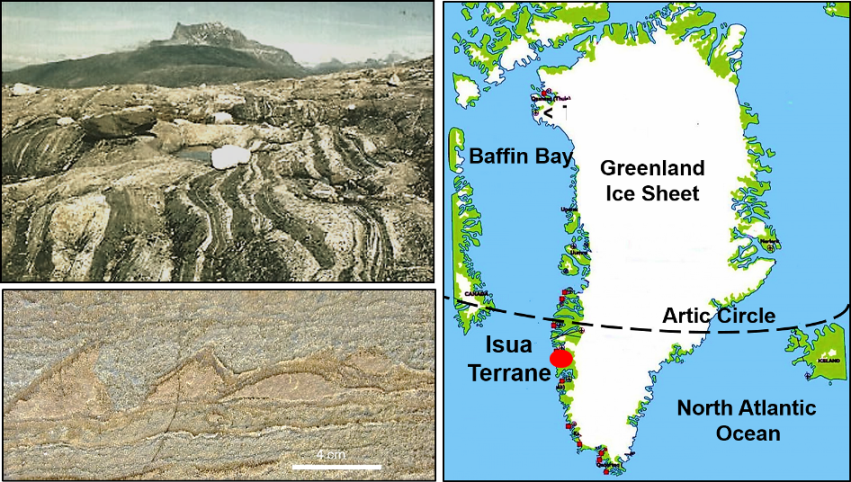
Searching for evidence of ancient life on Earth
Possible evidence for the existence of life on Earth provided by the Isua Terrane rocks is tantalizing, but it does not by itself provide documented proof of life. Such documentation requires examples of actual body fossils, which up until the mid-1960s was lacking, and that was a frustrating situation for paleontologists.
The groundbreaking discovery of cellular fossils was made by accident. An economic geologist named Stanley Tyler was studying iron-bearing rocks in the Great Lakes region and noticed tiny spherical structures in thin sections of rocks under a microscope. He got in touch with paleobotanist Elso Barghoorn at Harvard University and sent him the samples. Barghoorn determined that the structures were actually preserved bacterial cells. They collaborated on a paper reporting the first recognized Precambrian cellular fossils in 1965 (Science, vol. 147, p. 563–577). These microfossils were from the Gunflint Chert, which is approximately 2 billion years old.
This discovery literally opened the floodgates, sort of like a paleontological gold rush, as the report provided a clue as to the type of rock (microcrystalline chert) in which to look for these fossils. Within a short time, numerous discoveries of similar cellular fossils had pushed the time framework for life on Earth back to at least 3.5 billion years ago (Figure 3).
The fossil record of microbes
We now recognize that biologic metabolic processes may have occurred on Earth by 3.8 billion years ago, perhaps even earlier. We also recognize that cellular fossils of bacteria and bacteria-like organisms known as Archaea were present by about 3.5 billion years ago (Figure 3). These micro-organisms probably existed in a variety of ancient environments, some of which are considered extreme by today’s standards (Figure 4).

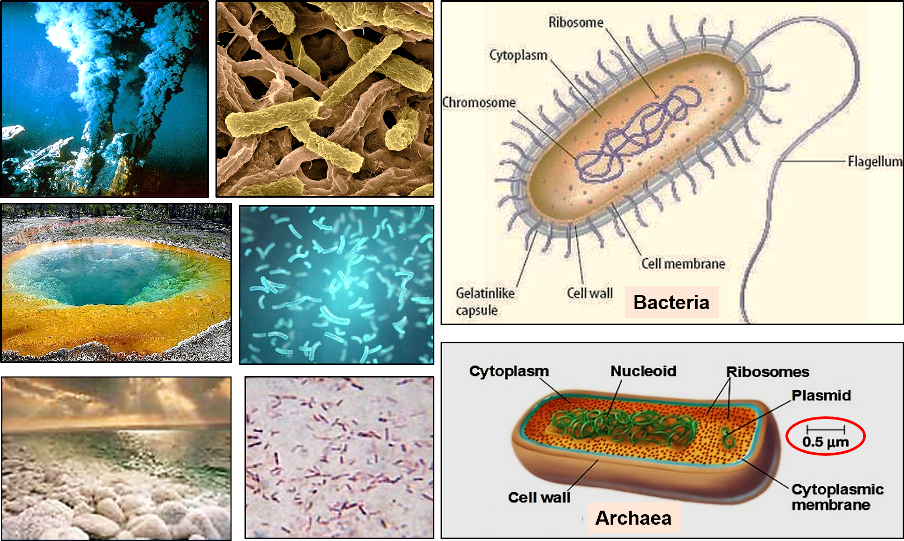
Additionally, organo-sedimentary structures known as stromatolites may have been present 3.8 billion years ago and were widespread by 3.5 billion years ago. In a few locations with abnormal environmental conditions — such as Shark Bay, Australia — these structures are forming today (Figure 5).
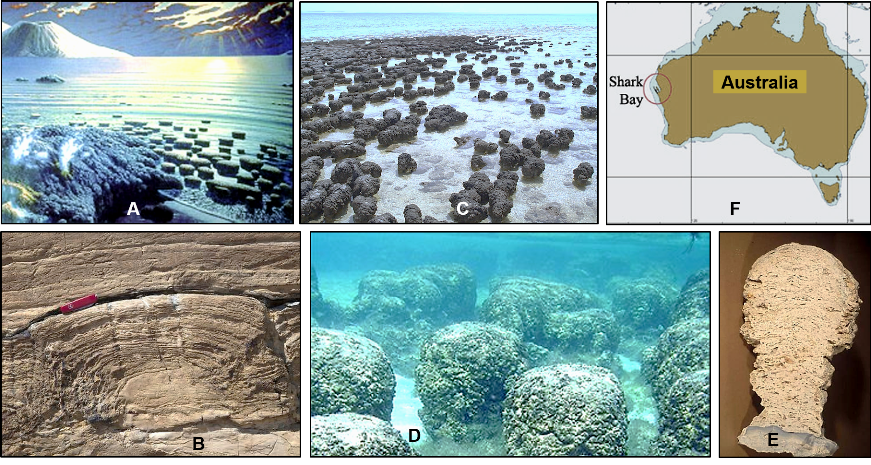
Stromatolites have a long geologic record extending back at least 3.5 billion years. They are formed by successive layers of cyanobacterial mats, which trap fine-grained sediments in shallow marine water.
Of major significance are the cyanobacteria that form these structures. They are common today and produce energy by photosynthesis (Figure 6). As well known from high school biology classes, a byproduct of the photosynthesis reaction is oxygen. Thus, it is likely that oxygen was being added to Earth’s atmosphere by 3.5 billion years ago. Most evidence indicates the Earth’s atmosphere lacked oxygen, so the beginning of organic photosynthesis was a significant event in Earth’s history.
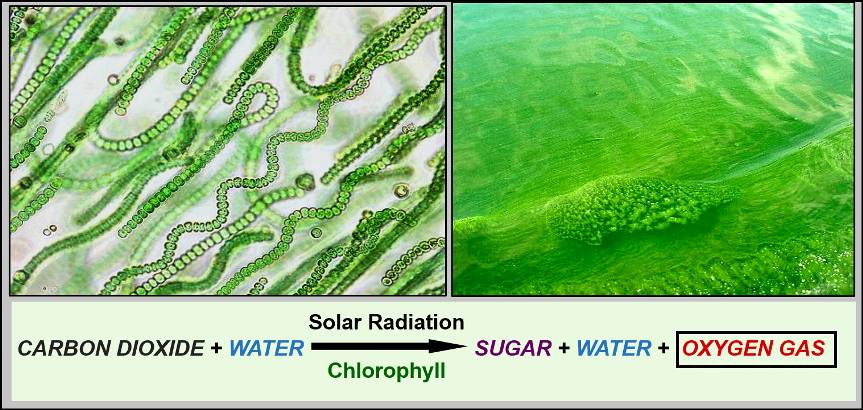
This brief review of the early rock and fossil records of Earth, along with the information about energy sources and how the basic cycles operate on Earth that were discussed in part 1, provides a model which can be used to interpret evidence that has been obtained from Mars by NASA and other space agencies. If it can be determined from this evidence that ancient conditions on Mars were similar to those existing on Earth, a hypothesis can be proposed that life may have also existed on the red planet.
This is the topic to be presented in part 3. I will compare some of the geologic features NASA has recorded on Mars with similar geologic features recorded by geologists on Earth. This comparison can provide an indication if conditions on Mars were appropriate for life.




Honky Dory. Look at those cavemen go! I would say odds are highly likely there was life on Mars. Is there still life on Mars? Or maybe intelligent life on Mars? Hmmm, pushing it, but it is in the realm of possibility as one would assume a SUBTERRANEAN existence at best. But as far as microbes go, even Vegas isn’t going to give you good odds if you lay down that bet. My guess, and we shall see one day, is that life is way more common in the universe then current Science accepts. Cool article. PS. Bowie show at Tuacahn in a few weeks. They better play that “Life on Mars” song or I will ask for a full refund!